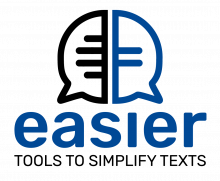Noticias
2021
Grupo HULAT en CEDI 20/21
Del 22 al 24 de septiembre, se celebrará el Congreso Español de Informática, CEDI 20/21 en Málaga. Desde el grupo HULAT participaremos en distintos congresos en el marco del CEDI 20/21. Se participará en el First Workshop on Current Trends in Text Simplification (CTTS-2021) dentro del congreso de la SEPLN 2021, Rodrigo Alarcon presentará el trabajo “Exploration of Spanish Word Embeddings for Lexical Simplification steps”. Además se presentará el trabajo “Designing and Evaluating a User Interface for People with Cognitive Disabilities” en el congreso Interacción 20/21.Publicación del artículo “Lexical Simplification System to Improve Web Accessibility” en la revista IEEE Access.
 Las personas con discapacidades intelectuales, del lenguaje y del aprendizaje se enfrentan con barreras de accesibilidad cuando leen textos con palabras complejas. Para ofrecer apoyo a la lectura, en este trabajo se presenta un sistema de simplificación léxica para el español. El sistema cubre la tarea de identificación de palabras complejas y ofrece candidatos de reemplazo con la tarea de generación y selección de sustitutos. Se han utilizado métodos de aprendizaje automático e incrustaciones contextuales utilizando recursos de lectura fácil y lenguaje claro, como diccionarios y corpus. Estos hallazgos representan un avance en la simplificación léxica de textos en español y en un dominio genérico usando recursos de fácil lectura. Los autores del artículo son Rodrigo Alarcon, Lourdes Moreno y Paloma Martínez del grupo HULAT en el marco del proyecto EASIER.
Las personas con discapacidades intelectuales, del lenguaje y del aprendizaje se enfrentan con barreras de accesibilidad cuando leen textos con palabras complejas. Para ofrecer apoyo a la lectura, en este trabajo se presenta un sistema de simplificación léxica para el español. El sistema cubre la tarea de identificación de palabras complejas y ofrece candidatos de reemplazo con la tarea de generación y selección de sustitutos. Se han utilizado métodos de aprendizaje automático e incrustaciones contextuales utilizando recursos de lectura fácil y lenguaje claro, como diccionarios y corpus. Estos hallazgos representan un avance en la simplificación léxica de textos en español y en un dominio genérico usando recursos de fácil lectura. Los autores del artículo son Rodrigo Alarcon, Lourdes Moreno y Paloma Martínez del grupo HULAT en el marco del proyecto EASIER.
"Framework for the Classification of Emotions in People With Visual Disabilities Through Brain Signals" paper published in Frontiers in Neuroinformatics journal
Entrevista de radio en "Hoy por Hoy" de la SER, explicando el proyecto EASIER,
 Entrevista de radio en "Hoy por Hoy" de la SER a Lourdes Moreno del grupo HULAT por el proyecto EASIER, un sistema de simplificación léxica en español para hacer la información accesible a las personas con discapacidad intelectual financiado por INDRA y Fundación Universa. En este proyecto se han utilizado técnicas de accesibilidad y de Procesamiento de Lenguaje Natural.
Entrevista de radio en "Hoy por Hoy" de la SER a Lourdes Moreno del grupo HULAT por el proyecto EASIER, un sistema de simplificación léxica en español para hacer la información accesible a las personas con discapacidad intelectual financiado por INDRA y Fundación Universa. En este proyecto se han utilizado técnicas de accesibilidad y de Procesamiento de Lenguaje Natural.
"An IoT-based contribution to improve mobility of the visually impaired in Smart Cities" paper published in Computing journal (Springer)
In this work, an integrated framework with an IoT architecture customized for an electronic cane (electronic travel aid designed for the visually impaired) has been designed. The architecture is organized by a five-layer architecture: edge technology, gateway, Internet, middleware and application. This new feature brings the ability to connect to environment devices, receiving the coordinates of their geographic locations, alerting the user when it is close to anyone of these devices and sending those coordinates to a web application for smart monitoring. Preliminary studies and experimental tests with three blind users of the Cane show that this approach would contribute to get more spatial information from the environment improving mobility of visually impaired people.
Plataforma EASIER, una ayuda en la comprensión de los textos
 EASIER es una plataforma que ayuda a las personas a comprender mejor los textos y funciona apoyándose en métodos de inteligencia artificial. Básicamente proporciona simplificación léxica de los textos en español ofreciendo distintas ayudas a la comprensión.
EASIER es una plataforma que ayuda a las personas a comprender mejor los textos y funciona apoyándose en métodos de inteligencia artificial. Básicamente proporciona simplificación léxica de los textos en español ofreciendo distintas ayudas a la comprensión.
“Disambiguating Clinical Abbreviations Using Pretrained Word Embeddings” accepted in HEALTHINF 2021 conference
"Deep-Sync: A novel deep learning-based tool for semantic-aware subtitling synchronisation" paper published in "Neural Computing and Applications" journal
In this paper, we present Deep-Sync, a tool for the alignment of subtitles with the audio-visual content. The architecture integrates a deep language representation model and a real-time voice recognition software to build a semantic-aware alignment tool that successfully aligns most of the subtitles even when there is no direct correspondence between the re-speaker and the audio content. Deep-Sync was compared with other subtitles alignment tool, showing that our proposal is able to improve the synchronisation in all tested cases.Participation of HULAT in SDU@AAAI-21: A Hybrid Approach to Disambiguate Scientific Acronyms
 Participation of HULAT in SDU@AAAI-21 shared task for Acronym Disambiguation. The work will be presented inAAAI-21 Workshop on Scientific Document Understanding, February 9 2021
Participation of HULAT in SDU@AAAI-21 shared task for Acronym Disambiguation. The work will be presented inAAAI-21 Workshop on Scientific Document Understanding, February 9 2021
